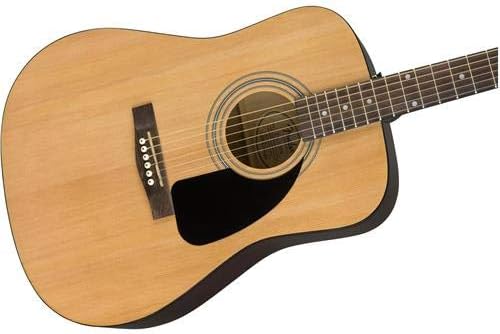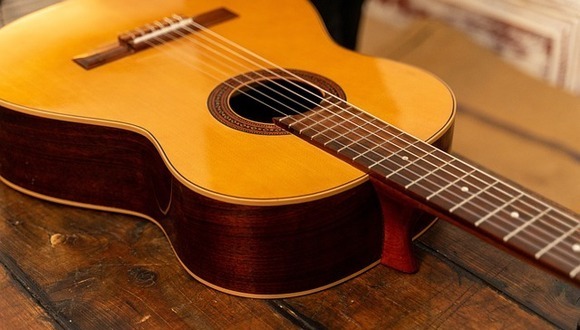Fender FA 115 vs. Yamaha F310: A Comprehensive Comparison for Beginners
When it comes to starting your acoustic guitar journey, choosing the right instrument can make all the difference. Two models that frequently appear in discussions among beginners are the Fender FA 115 and the Yamaha F310. Both guitars are celebrated for their affordability, playability, and reliable performance. In this article, we’ll break down the features, sound quality, playability, and overall value of each guitar to help you decide which one might be the best fit for your musical journey.

Overview of the Fender FA 115
Design and Construction
The Fender FA 115 is designed with the classic dreadnought body shape—a style known for its full, rich sound and strong projection. It features:
- Laminated Spruce Top: The spruce top contributes brightness and clarity, offering an articulate sound that cuts through in both practice sessions and small gigs.
- Laminated Basswood Back & Sides: While laminate woods are a common cost‑saving measure in entry‑level guitars, Fender’s build quality ensures a balanced, warm tone.
- Comfortable Neck Profile: Many users appreciate the smooth, comfortable neck of the FA 115. It’s engineered to reduce finger fatigue, making it ideal for beginners who are still developing finger strength and dexterity.
Aesthetic and Playability
Fender has kept the FA 115’s design simple and classic. Its minimalistic finish allows the natural beauty of the wood to shine through, and the dreadnought shape is both familiar and versatile. Out‑of‑the‑box playability is one of the model’s strong points, with a setup that typically requires minimal adjustments before you start strumming your favorite tunes.
Price and Value
The FA 115 is usually priced very competitively for an entry‑level guitar. Its affordability, coupled with Fender’s trusted brand name, makes it an attractive option for beginners who want a reliable instrument without breaking the bank.
Overview of the Yamaha F310
Design and Construction
Yamaha is well known for its consistent quality in the budget acoustic market, and the F310 is no exception:
- Spruce Top: Like the FA 115, the Yamaha F310 typically features a spruce top that helps deliver a clear, bright tone with excellent projection.
- Meranti Back & Sides: The F310 usually uses meranti (a wood with tonal properties similar to mahogany) for its back and sides. This construction choice contributes to a balanced tonal character and adds a bit more emphasis on midrange warmth.
- Solid Playability: Yamaha has a reputation for excellent playability. The F310 is designed with a comfortable neck and a well‑set action, making chord transitions smooth and ensuring that even long practice sessions remain enjoyable.
Included Accessories and Extras
One key differentiator for the Yamaha F310 is that it is often sold as part of a package that includes useful accessories. Many buyers find that:
- Soft Case, Capo, and Tuner: These extras add value, especially for beginners who might not yet own essential accessories.
- Starter Package Appeal: The bundled items mean you can start playing right away without the additional cost of purchasing a case or tuner separately.
Price and Value
Although the Yamaha F310’s base price is very comparable to the Fender FA 115, the inclusion of accessories can tip the scales for many beginners. When you factor in these extras, the F310 often represents excellent value, particularly for those who want an all‑in‑one starter package.
Comparing Tone and Sound Quality
Fender FA 115 Tone
The Fender FA 115 is renowned for its warm, balanced tone. Its laminated spruce top, though not equivalent to a solid wood top, still offers plenty of brightness and clarity. The dreadnought shape enhances the bass response, providing a full-bodied sound that is ideal for strumming and rhythm playing. Many players report that the FA 115’s sound is robust enough for both practice and small acoustic gigs.
Yamaha F310 Tone
The Yamaha F310, on the other hand, is often praised for its crisp, bright tone. The spruce top works in tandem with the meranti back and sides to produce a sound that is both clear and balanced. While some players find the F310’s tone to be slightly more focused than the FA 115’s, this characteristic can be beneficial if you’re looking for an instrument that cuts through a mix or works well in ensemble settings.
Real-World Feedback
A Reddit discussion comparing similar models (for example, the Fender FA 125 vs. Yamaha F310) highlights that while both guitars offer comparable sound quality, some users prefer the Yamaha for its consistent brightness and the added extras in its package (
reddit.com). Meanwhile, Fender fans might lean toward the FA 115 for its signature warmth and Fender’s familiar design language.
Playability and Ergonomics
Neck and Action
Both guitars are designed with the beginner in mind, featuring comfortable neck profiles and low action:
- Fender FA 115: Its neck is engineered for ease of play, with smooth fret transitions and a shape that supports long practice sessions without causing undue strain.
- Yamaha F310: Yamaha’s focus on playability is evident in the F310’s ergonomic design, ensuring that chord changes and scale runs are effortless.
Setup and Adjustments
While factory setups are generally good on both models, some players may find that minor adjustments (such as tweaking the action) can enhance playability further. For beginners, having an instrument that “just plays” right out of the box is a significant advantage, and both the FA 115 and the F310 tend to deliver on this front.
Pros and Cons
Fender FA 115
Pros:
- Affordable entry‑level price with reliable Fender build quality.
- Warm, full-bodied tone suitable for strumming and small gigs.
- Comfortable neck and playability ideal for beginners.
- Classic dreadnought design that appeals to traditionalists.
Cons:
- Uses laminate construction, which may not provide the depth of sound found in higher‑end guitars.
- Typically sold as a guitar only—accessories must be purchased separately.
- May require minor setup adjustments to achieve optimal playability.
Yamaha F310
Pros:
- Comparable price point with the added value of included accessories (soft case, capo, tuner, strings).
- Crisp, bright tone with balanced mids and clear projection.
- Excellent playability with an ergonomic neck and low action.
- Consistent quality and reliability synonymous with the Yamaha brand.
Cons:
- Some players might find the tone a bit too bright if they prefer a warmer sound.
- The overall aesthetic is very straightforward, which may not appeal to those looking for a more “designer” look.
- As with most budget instruments, individual quality control can vary; it’s advisable to try the guitar in person if possible.
Which One Should You Choose?
Consider Your Budget and Needs
Both the Fender FA 115 and Yamaha F310 offer great value for money, but your decision might come down to what’s most important to you as a beginner:
- If you prefer a classic Fender tone and design, and you’re willing to purchase accessories separately, the FA 115 might be the ideal choice. Its warm, full‑bodied sound and comfortable playability make it a reliable companion for your early musical explorations.
- If you value the convenience of a starter package with extras, along with a bright, clear tone, then the Yamaha F310 is hard to beat. The inclusion of a case, capo, tuner, and extra strings provides everything you need to get started without additional investment.
Personal Preference and Playability
Ultimately, playability is key. The best guitar for you is the one that feels right in your hands and inspires you to play. While online reviews and specifications can guide your decision, if you have the opportunity to test both instruments in a store, do so. Notice which neck profile, action, and overall feel resonate with you. Both models have earned their places in the beginner market, and the slight differences in tone and aesthetics mean that personal taste will play a major role.
Long-Term Considerations
Keep in mind that as you progress, your tonal preferences and playing style might evolve. An entry‑level guitar like the FA 115 or F310 is designed to be a starting point—a stepping stone to more advanced instruments. Whichever guitar you choose should serve you well in the early stages of your musical journey and offer a solid foundation on which to build your skills.
Final Verdict
The battle between the Fender FA 115 and Yamaha F310 is not about declaring a definitive “winner,” but rather about understanding the unique benefits each offers to the beginner guitarist. Both instruments deliver on the promise of affordability, reliability, and decent sound quality:
- Fender FA 115 stands out with its classic Fender warmth, traditional dreadnought design, and proven playability. It’s perfect for those who are loyal to the Fender brand and value a time‑honoured tone.
- Yamaha F310 excels with its bright, clear tone, ergonomic design, and the added value of a comprehensive starter package. It’s a smart choice if you’re looking for an all‑in‑one solution that allows you to get playing without needing to invest in additional accessories.
For anyone venturing into the world of acoustic guitars, both the Fender FA 115 and Yamaha F310 represent excellent choices that can kickstart your musical journey without a hefty price tag. Ultimately, the decision should be based on your personal playing style, aesthetic preference, and whether the bundled extras of the F310 offer the convenience you need.
Conclusion
In the end, the choice between the Fender FA 115 and the Yamaha F310 comes down to individual preference. Both guitars offer solid construction, good playability, and a tone that is more than capable of supporting a beginner’s learning experience. By weighing factors such as tone, accessories, and overall feel, you can make an informed decision that will help you nurture your passion for playing the guitar.
Whether you lean toward the classic vibe of the Fender FA 115 or the practical, package‑dealing Yamaha F310, you’re investing in an instrument that will serve as a stepping stone to greater musical achievements. Happy strumming!


